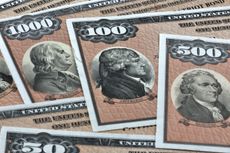3 Higher-Risk, Higher-Reward Ways to Earn Dividends
Get tasty yields from a smorgasbord of investments, from tankers to trusts.
You can find plenty of good common stocks with spiffy yields. But if getting 3% or 4%, or maybe a little more, from a regular stock doesn't float your boat, you may want to turn to securities that are a little more esoteric.
MLPs
Let's start with master limited partnerships. MLPs are publicly traded limited partnerships. They don't pay taxes; investors, the limited partners, do. MLPs must distribute to investors nearly all the cash flow they generate, resulting in high yields. However, MLPs can complicate your tax returns -- even, potentially, if you hold them inside of an IRA.
Most MLPs derive most of their income from real estate or natural resources. The highest yielders extract, transport and store oil and natural gas. A nice thing about the pipeline businesses is that performance isn't tied to the price of oil or gas. Rather, such MLPs make their money by moving and processing the commodities. Jerry Swank, who runs Cushing MLP Total Return (symbol SRV), a closed-end fund, says that energy MLPs are capable of producing total returns -- from distributions and price appreciation -- of 10% to 15% a year.

Sign up for Kiplinger’s Free E-Newsletters
Profit and prosper with the best of expert advice on investing, taxes, retirement, personal finance and more - straight to your e-mail.
Profit and prosper with the best of expert advice - straight to your e-mail.
Look for MLPs that can boost their distributions on a steady basis. A good place to start is Kinder Morgan Energy Partners (KMP). This Houston pipeline-and-storage firm increased its distribution by 8% in 2010. At $72, it yields 6.2% (all prices, yields and returns are through February 11). Boardwalk Pipeline Partners (BWP), another Houston pipeline company, has raised its dividend every quarter since going public in 2005. At $33, the units, as MLP shares are called, yield 6.2%.
Royalty Trusts
Like MLPs, royalty trusts typically invest in energy assets, they don't pay taxes, and they pay out nearly all of their cash flow. However, royalty trusts own actual commodities and make money from selling the oil, natural gas or coal they own.
Because royalty trusts are pure commodity plays, their share prices and distributions fluctuate with commodity prices. Also, be aware that trusts have a limited lifetime. When the commodity is depleted, the trust shuts down. San Juan Basin Royalty Trust (SJT), of Fort Worth, owns natural-gas-producing properties in New Mexico's San Juan Basin and should last at least ten more years. At $24, the trust yields 6.9%. BP Prudhoe Bay Royalty Trust (BPT) owns an oil field in Alaska that isn't expected to close before 2023. At $107, the trust yields 8.2%.
Closed-End Funds
Closed-end funds trade like stocks. But unlike their newer and more popular cousins, exchange-traded funds, closed-ends don't contain the mechanisms that prevent their share prices from diverging significantly from the value of their underlying holdings.
One closed-end to consider is NFJ Dividend Interest & Premium Strategy (NFJ), which, at $18, sold at a 7% discount to NAV. The fund holds 61% of its assets in U.S. stocks and 11% in European stocks. In addition, it earns extra income by selling call options (which give the buyer the right to buy a stock at a certain price by a certain time). The fund yields a stellar 10.2%. Over the past year, it returned 18.2% on its assets, compared with 25.7% for Standard & Poor's 500-stock index. Annual expenses, at 0.98%, are reasonable.
If you prefer ETFs, check out Guggenheim Multi-Asset Income ETF (CVY). It holds 148 securities, including U.S. stocks, preferred stocks, real estate trusts, MLPs, closed-end funds and foreign stocks. Financial companies and utilities make up 45% of the portfolio. The ETF, which yields 4.6%, returned 5.2% over the past year. The annual fee is 0.6%.
-
 What Happens Financially When You Work One More Year?
What Happens Financially When You Work One More Year?The impact of saving more, spending less later and benefiting from an extra year or more of compounding can be truly staggering.
By Andrew Rosen, CFP®, CEP Published
-
 Seven Ways to Spend Your Tax Refund
Seven Ways to Spend Your Tax RefundYou may want to splurge, but using your tax refund to save for the future or pay down debt is a much better idea — even if not as fun.
By Kathryn Pomroy Published
-
 Best Banks for High-Net-Worth Clients
Best Banks for High-Net-Worth Clientswealth management Kiplinger's 2023 list of the best banks for higher-net-worth clients.
By Lisa Gerstner Published
-
 Stock Market Holidays in 2024: NYSE, NASDAQ and Wall Street Holidays
Stock Market Holidays in 2024: NYSE, NASDAQ and Wall Street HolidaysMarkets When are the stock market holidays? Take a look at which days the NYSE, Nasdaq and bond markets are off in 2024.
By Kyle Woodley Last updated
-
 Stock Market Trading Hours: What Time Is the Stock Market Open Today?
Stock Market Trading Hours: What Time Is the Stock Market Open Today?Markets When does the market open? It's true the stock market does have regular hours, but trading doesn't necessarily stop when the major exchanges close.
By Michael DeSenne Last updated
-
 Bogleheads Stay the Course
Bogleheads Stay the CourseBears and market volatility don’t scare these die-hard Vanguard investors.
By Kim Clark Published
-
 I-Bond Rate Is 5.27% for Next Six Months
I-Bond Rate Is 5.27% for Next Six MonthsInvesting for Income I-Bonds issued November 1, 2023 through April 30, 2024 will have a rate of 5.27%.
By David Muhlbaum Last updated
-
 What Are I-Bonds?
What Are I-Bonds?savings bonds Inflation has made Series I savings bonds enormously popular with risk-averse investors. So how do they work?
By Lisa Gerstner Last updated
-
 This New Sustainable ETF’s Pitch? Give Back Profits.
This New Sustainable ETF’s Pitch? Give Back Profits.investing Newday’s ETF partners with UNICEF and other groups.
By Ellen Kennedy Published
-
 As the Market Falls, New Retirees Need a Plan
As the Market Falls, New Retirees Need a Planretirement If you’re in the early stages of your retirement, you’re likely in a rough spot watching your portfolio shrink. We have some strategies to make the best of things.
By David Rodeck Published